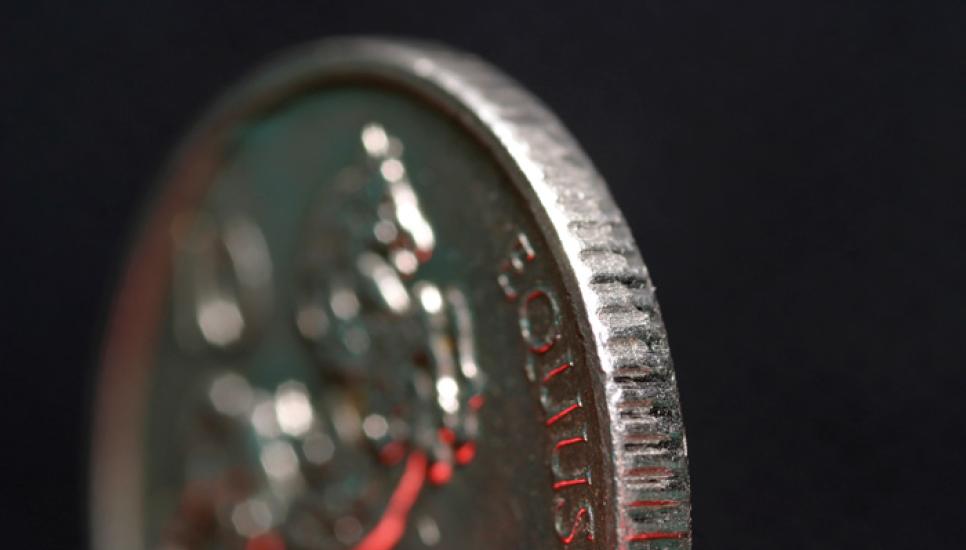Worth a pretty penny: Investing in cold hard coins

The extraordinary success of the Rothschild banking dynasty can be traced back to a young man with a passion for collecting coins.
According to the family archive, Mayer Amschel Rothschild became interested in coins as a small boy and had not even reached his mid-teens when, in 1757, he took up a job in a bank's rare-coins department.
Even back then there was much interest in coins as investments, and the diversity of material dealt with by the bank – pieces from Persia, Byzantium, and Rome among them – must have fascinated the young Rothschild.
He later became a coin dealer himself, and it was the royal connections he made through this work that ultimately led to the creation of the banking empire that became such a global force.
Collecting coins, then, can be much more than just a hobby.
 For 51-year-old Briton Chris Atkinson they are an important part of his investment portfolio. The former Microsoft vice-president has put £230,000 ($251,000) into around 30 coins. One of them a silver penny showing William the Conqueror, the Norman invader to England whose victory at the Battle of Hastings in 1066 ended Saxon rule.
For 51-year-old Briton Chris Atkinson they are an important part of his investment portfolio. The former Microsoft vice-president has put £230,000 ($251,000) into around 30 coins. One of them a silver penny showing William the Conqueror, the Norman invader to England whose victory at the Battle of Hastings in 1066 ended Saxon rule.
“It's a beautiful coin, literally struck in Hastings just after the battle,” says Atkinson, who is originally from Norfolk in England but who now lives in his wife's native Guernsey. There his coins are kept in a vault managed by Stanley Gibbons, the coins and collectibles dealer who sold them. His coins span the centuries – and the monarchs – with the most recent dating from 1826.
Like many of those who invest in the collectible, Atkinson has long been a coins enthusiast, and keeps 100 or so pieces he collected as a youngster.
“If you're going to invest in paintings or coins or stamps, it's really important you invest in something you think is beautiful and you really like,” he adds.
But his decision to invest in coins came as much from his head as his heart. He says that, over the past 200 years, there was probably never a time when investing in coins was a bad move.
“I felt they were a very safe bet. If you look at premium coins during the last years, they've always gone up in value … It's a good thing to do with a small percentage of your net worth – to invest in coins, stamps or tangible rarities. In the past I've bought shares. They can wither away to nothing. That will not happen with a coin,” he says.
While stamp collecting began in only the mid-19th century, not long after the first stamps were issued, coin collecting or numismatists has a much longer history, not least because coins have been produced for more than 2,500 years.
According to some accounts, the first Roman Emperor, Augustus, who lived from 63BC to 14AD, did not just appear on coins – he collected them, too. The depth of history represented by coins is a key part of the attraction of numismatists.
“In terms of historical interest, it's a nice thought that you're holding and looking at an object held and looked at by numerous people from centuries ago. It's a physical object you know has passed through other people's hands,” says Maria Vrij, interim curator of the coin collection at the Barber Institute of Fine Arts in Birmingham, England.
Although some coins from Ancient Rome can be bought for just a few dollars, others are within the reach of only wealthy investors. Coins featuring Emperor Augustus may be traded online for $10,000 apiece, and the most sought-after pieces realise auction prices that dwarf even this.
Most of the top prices have been achieved in the US, where the market revolves around American coinage. At a Florida auction in early 2015, a Beverly Hills coin dealer, Kevin Lipton, paid $2.59 million for a Birch Cent from 1792, a record for a one-cent piece. Two years earlier, the all-time highest figure paid for a coin was broken when Legend Numismatics, a New Jersey coin dealer, paid a little over $10 million at auction for a Flowing Hair Silver Dollar minted in 1794. The largest sum ever realised by a British coin is much more modest: £516,000 was paid in 2014 for a gold “proof” coin to mark the coronation of King Edward VIII in 1937, a coronation that never happened when the monarch abdicated in order to marry a divorcée. Like this proof coin, many of the most valuable pieces are unique in some way, with production errors, such as being struck off-centre or twice, especially in demand.
Even those investing much more modest amounts can eventually achieve useful returns if they choose carefully and hold on to their investments.
 “Not every investment in coins is a collection, but every collection of coins is an investment,” says David L Ganz, a New Jersey-based lawyer who began buying coins in 1960 and has authored such books as Profitable Coin Collecting, Rare Coin Investing and Planning Your Rare Coin Retirement.
“Not every investment in coins is a collection, but every collection of coins is an investment,” says David L Ganz, a New Jersey-based lawyer who began buying coins in 1960 and has authored such books as Profitable Coin Collecting, Rare Coin Investing and Planning Your Rare Coin Retirement.
“If you systematically collect in some manner, and hold it for a long enough time, it will be an investment and it will be of value.”
Ganz knows this well. As a youngster in the 1960s he began collecting Hawaiian coins – one cent pieces, dimes, quarters, half dollars, and nickels among them – trading pieces in and buying better ones whenever he had the money to spare. He built up his collection during the next two decades.
“I sold my collection in 1996 when I decided to buy a house. The collection formed a good down payment,” says the 64-year-old.
One particular coin, a Hawaiian nickel bought for $21 in 1969, was auctioned off for $450.
Fast forward nearly two decades, and US coins are achieving record amounts at auction. According to the Professional Numismatists Guild (PNG), they realised $536 million at auction in 2014, more than a third up on the previous year's figure of $393 million, itself a record.
Enthusiasm for investing in coins is not confined to the US and Europe. With its growing number of wealthy, China is becoming an increasingly important market, with millionaires laying claim to their country's heritage and buying up trophy assets from other parts of the world.
There is also keen interest in India. The Hinduja Foundation, the philanthropic organisation associated with the Indian industrial conglomerate the Hinduja Group, recently unveiled a collection of more than 35,000 coins and other artefacts from the bequest of a former British Army officer. The foundation plans to collaborate with museums to display the collection, which includes pieces from as far back as 600BC, when ancient India became one of the first places in the world to produce coins.
 Much more recent Indian coins have fetched record prices at auction, albeit far short of sums achieved in the US and Europe. In 2012 a record paid for an Indian coin in India was set when a businessman, Arvind Kumar, paid 13 lakh Indian rupees (approximately $19,681) for an 1835 “Two Mohurs” coin, minted while India was under British rule.
Much more recent Indian coins have fetched record prices at auction, albeit far short of sums achieved in the US and Europe. In 2012 a record paid for an Indian coin in India was set when a businessman, Arvind Kumar, paid 13 lakh Indian rupees (approximately $19,681) for an 1835 “Two Mohurs” coin, minted while India was under British rule.
Statistics demonstrate the strength of coins as things in which to invest. According to the Knight Frank Luxury Investment Index, in 2014 coins grew in value by 7%, compared to the 10% average for luxury goods. Over five years they achieved 38% growth, and over 10 years the return was 234%. That ranks coins above stamps (195%), watches (168%) and wine (167%), among others. In the 10-category survey, coins were outpaced only by cars (487%) and coloured diamonds (252%).
Keith Heddle, managing director of investments for Stanley Gibbons, says the coins market has seen “steady accumulation since 2009”.
“Collectors have gone back to their collections and investors have come in, but not in a speculative way like they did with fine wines; the pressures on demand are on a more measurable level,” he says.
“We are seeing a rate of between six and, at the top end, 16% growth per annum, depending on what you're holding.”
So although coins represent “a nice slow-burning investment” that Heddle says is not subject to the whims and trends of some other asset classes, he and others acknowledge that the collectibles market tends to move in an erratic way. Coins can move in – and out – of fashion.
“What different coins cost at different times will change. At the moment Arab-Byzantine coins are going for quite a lot of money,” says Vrij, referring to coins produced in former Byzantine areas such as Egypt and Syria that, in the early 7th century, were taken over and influenced by Arab and Muslim culture.
Just as these coins have become popular, interest in others has fallen away and Vrij notes that estimated values of individual pieces in collections sometimes have to be adjusted downwards.
Given these variations, the coin market may appear intimidating to those without experience. Should it therefore be left to those with detailed knowledge built up over many years of collecting? Ganz urges potential investors not to feel intimidated.
“There are enough books out there you can easily satisfy yourself as to the technical requirements of coin investments,” he says, while cautioning that investors should not put in more money than they can afford to lose.
Tom Caldwell, president and founder of Massachusetts-based coin dealer Northeast Numismatics, which has dealt in individual coins worth up to about $500,000, says those investing in coins represent “all spectrums of knowledge”, including some who are completely new to the sector. He sees some level of background knowledge as preferable.
“I would really advise folks to gain some knowledge from the get-go and not look at it simply as an investment. Find some areas that interest them. Do a little diversification. Not just one area. We like to have folks who have a real interest. It doesn't have to be a passion they're spending all their time on,” he says.
“If they're looking at 100% just as investment, if the results are not [good] in the short term, they will end up selling sooner rather than later,” adds Ganz.
There are numerous pitfalls for the unwary. Fraud can be a real concern for coin investors, and there have been numerous instances where individuals have lost significant sums because of unscrupulous dealers. In one high-profile US case, Joseph Romano attracted $40 million worth of investments from more than 1,500 people by claiming that coins were worth much more than their actual market price before being jailed for fraud. In August 2015, Californian rare coin dealer Hannes Tulving admitted taking money from customers even though he was unable to supply their goods, the fraud amounted to more than $15 million.
Law firms, legal officials and the American Numismatic Association offer advice on combating fraud, suggesting that investors should avoid television promotions, hire independent experts to value coins, and check on the history of dealers, especially as the market is not regulated.
The internet has, as Ganz puts it, made the market “much more instantaneous and much more responsive”, but users have to be extra careful about what they are buying. Donn Pearlman is a former American Numismatic Association board member who has lengthy experience promoting coin collecting. He advises buyers, once they have read up about the market, to work with a professional dealer before making an investment, and suggests representatives of the PNG, which is US-based but also has members in other parts of the world. There are also professional authentication companies such as the Numismatic Guaranty Corporation, which is linked to the PNG, and the Professional Coin Grading Service.
 “Generally, the best returns are achieved by assembling a collection of truly rare, highest-available-quality coins or bank notes, each certified for authenticity and grade by a major respected certification service,” says Pearlman.
“Generally, the best returns are achieved by assembling a collection of truly rare, highest-available-quality coins or bank notes, each certified for authenticity and grade by a major respected certification service,” says Pearlman.
Some dealers, such as Stanley Gibbons, offer lifetime guarantees of authenticity and say the slightly higher charges they sometimes levy are offset by the security offered to buyers. Heddle warns buyers making purchases independently to carry out “due diligence” on the auction house or dealer. After all, finding, when it arrives, that a coin has a fault it was not supposed to have is costly.
“There are two issues in the market. One is forgeries, which is prevalent in every collectible class. The second is more subtle: condition,” says Heddle from Stanley Gibbons.
“If you see a coin on eBay or at a coin dealer and it's described as EF – extremely fine. You spend your money and it's got a hairline crack. As with anything, if you're buying heritage collectibles for investment, you need to go with trusted merchants.”
Although there are pitfalls, enthusiasts such as Atkinson insist that the benefits outweigh the drawbacks. Coins are, in his view, safe investments that offer many less tangible benefits.
“When you hold coins, you wonder how many people have held them over the years. They've had many owners; who knows who they've been? I'm just the next one in what will be a long series.”






